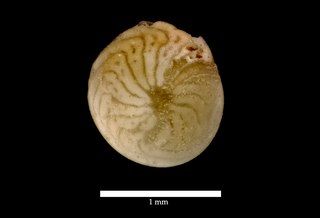Related Research Articles

The Globigerinina is a suborder of foraminiferans that are found as marine plankton. They produce hyaline calcareous tests, and are known as fossils from the Jurassic period onwards. The group has included more than 100 genera and over 400 species, of which about 30 species are extant. One of the most important genera is Globigerina; vast areas of the ocean floor are covered with Globigerina ooze, dominated by the shells of planktonic forms.

Globigerina is a genus of planktonic Foraminifera, in the order of Rotaliida. It has populated the world's oceans since the Middle Jurassic.
Discorbacea, Discorboidea in recent taxonomies, is a superfamily of foraminifera,, with a range extending from the Middle Triassic to the present, characterized by chambers arranged in a low trochspiral; an umbilical or interiomarginal aperture, with or without supplementary apertures; and a wall structure that is optically radial.
Abadehella is a genus of large Upper Permian benthic forams in the order Fusulinida. It is the sole known genus of the family Abadahellidae, for which the diagnosis is the same. Abadahellidae was established by Loeblich and Tappan 1984; Abadahella by Okimura and Ishi, 1975.

Globigerinoidea is a superfamily of free-living, calcareous, planktonic foraminiferal protists that have lived in the open ocean since the Eocene. It is part of the suborder Globigerinina.

Cibicides is a genus of cosmopolitan benthic foraminifera known from at least as far back as the Paleocene that extends down to the present.
Discorbis is a genus of benthic Foraminifera, that made its first appearance during the Eocene. Its present distribution is cosmopolitan.
Rosalina is a genus of foraminifera included in the rotaliid family Rosalinidae.
Rotorboides is a genus of recent (Holocene) bottom dwelling (benthic) forams from the Atlantic, Pacific and Indian Oceans, related to Rosalina.
Neoconorbina is a genus of recent (Holocene) discorbacean foraminifers related to Rosalina with a low conical trochoidal test, circular in outline. The conical side is the spiral side, on which all three whorls are visible, the final chamber taking up most of the periphery. The umbilical side is flat to concave. exposing only the three to four chambers of the final whorl around an open umbilicus. Chambers on the umbilical side have triangular to platelike umbilical extensions as with other rasalinids. The wall of is calcite, finely and densely perforate on the spiral side, more coarsely perforate on the umbilical side; surface smooth; aperture at the umbilical margin of the chamber, beneath the platelike extension, or folium.
Astrononion is a genus of foraminifera in the family Nonionidae, characterized by an evolute planispiral test with radially stellate structures partly covering the sutures on either side. The test is free, bilaterally symmetrical; periphery broadly rounded; chambers distinct, separated by depressed radial sutures, increasing gradually in size, and usually inflated; aperture a low arched opening at the base of the face of the test. The wall is of finely perforate monolamellar granular calcite.
Fabiania is a genus of large fossil benthic calcareous forams with a range extending from the Upper Paleocene to the Upper Eocene.
Hedbergella is an extinct genus of planktonic foraminifera from the Cretaceous, described by Loeblich and Tappan, 1961, as:
Test free, trochospiral, biconvex, umbilicate, periphery rounded with no indication of keel or poreless margin; chambers globular to ovate; sutures depressed, radial, straight or curved; wall calcareous, finely perforate, radial in structure, surface smooth to hispid or rugose; aperture an interiomarginal, extraumbilical-umbilical arch commonly bordered above by a narrow lip or spatulate flap, ... Includes species otherwise similar to Praeglobotruncana but which lack a keel or poreless margin, hence is regarded as a separate genus rather than as a subgenus of Praeglobotruncana as by Banner and Blow (1959).
Buccella is a genus of late Cenozoic benthic foraminifera that made its first appearance during the Oligocene and is found living in recent oceans.
Clavulinopsis is a genus of foraminifera from the Upper Cretaceous of the United States, included in the Textulariida. The type species is Clavulinopsis hofkeri Banner and Desai, 1985.
Cuneus is a genus of foraminifera in the Rotaliida found in Upper Cretaceous (Coniacian) to Paleocene marine sediments throughout the boreal regions.
Halenia is a genus of recent discorbacean foraminifera. It contains only one species, Halenia legrandi The test is free, a low trochspire with a rounded periphery; wall calcareous, monolamellar. Chambers are subglobular, all visible on spiral side, only last volution visible on umbilical side; final chamber with an umbilical flap. Sutures are depressed, radial on umbilical side, curved to sinuate on spiral side, with sutural slits on both sides.
Gansserina is a genus of planktonic foraminifera, included in the globigerinid family Globotruncanidae, that had a fairly wide distribution in the Late Cretaceous (Maastrichtian). The type species is Gansserina gansseri.

Amphistegina is a genus of foraminiferal protists included in the Rotaliida with a stratigraphic range extending from the Eocene to recent and a cosmopolitan distribution. The test is an asymmetrically biconvex trochospiral that may be bi-involute or partially evolute on the spiral side. Chambers are numerous, broad. and low, strongly curved back at the periphery to form chamber prolongations. The umbilical side is stellate, like that of Asterigerina, and has a distinct umbilical plug. The wall is calcareous, optically radial; the surface finely perforate and smooth overall. The periphery angular to carinate (keeled); the aperture an interiomarginal slit on the umbilical side, bordered by a lip.
Anania is an extinct genus of foraminifera of the family Ananiidae, order Globotruncanida. It was described in 2010 by Hamed El-Nakhal, and was initially classified in a new subfamily Ananiinae of the family Abathomphalidae. Later, the subfamily was raised into family Ananiidae and placed in the superfamily Hedbergelloidea.
References
- Abathomphalus uBio January 12, 2011.
- Hans M. Bolli, John B. Saunders, & Katharina Perch-Nielsen,1989. Plankton stratigraphy: Planktic foraminifera, calcareous nannofossils and calpionellids; CUP Archive.
- Loeblich A.R. jr, & H Tappan, 1988. Forminiferal Genera and their classification. (e-book) .